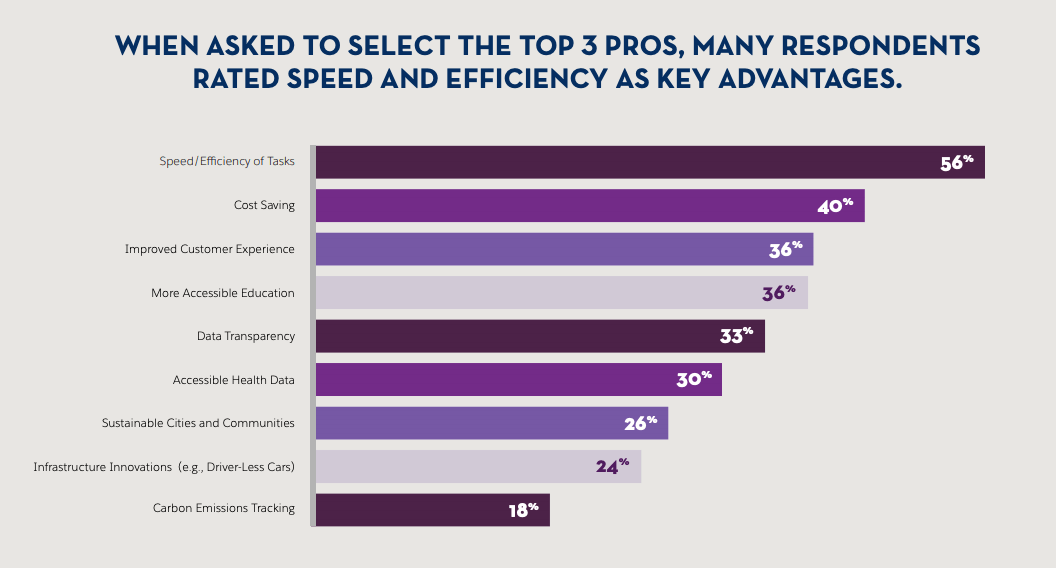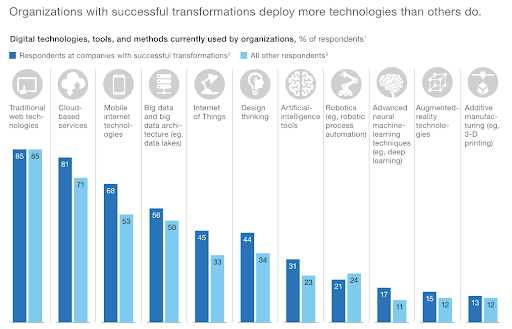Change in any organisation can be hard, especially when it’s necessary to push a company forward.
Digital transformation is no different. It’s when a business changes itself from the ground up to modernise itself. And unlike the name suggests, digital transformation goes beyond just investing in new technology—it also shifts company culture, expectations, and overall goals.
In this article, we will explain:
- What is digital transformation?
- What is digital transformation in business?
- Why is there a need for digital business transformation?
- 4 steps to a successful digital business transformation
Let’s get started.
What is digital transformation?
Digital transformation is a process where digital technology is introduced into every part of a business and revolutionises how you interact with and deliver value to customers.
As digital transformations require more than just switching out old technology for newer versions—it changes a company’s foundation and redefines how it delivers value to customers. It also means adapting every aspect of a company, from culture to customer service.
To ensure long-term success, you need to assemble a team that can plan and execute a complete transformation of your company’s digital tech stack. It’ll be up to them to not only switch out old processes and replace them with modern workflows, but to also sell the changes to the rest of the team.
Getting your entire company on board with the transformation can mean the difference between success and failure.
What is digital transformation in business?
Digitally transforming a business is no small task.
From converting paper records to digital ones to transferring customer records to a computer, digital transformation affects nearly every corner of your business. It requires you to:
- Move systems from analog to digital
- Use digitised information so your team can work simpler and more efficiently
- Leverage technology so you can automate mundane daily tasks
For business owners, the benefits of transforming their businesses and bringing them into a digital landscape are varied. When 528 employees were asked what they believed the most significant benefits of a digital transformation were, here’s what they said:
But the most important aspect of digital transformation business owners need to remember is this: everything is linked back to your customer and their experience with your brand. As Salesforce’s co-CEO Marc Benioff reminds us, the transformation begins and ends with them.
“Every digital transformation is going to begin and end with the customer, and I can see that in the minds of every CEO I talk to,” he says.
Why is there a need for digital business transformation?
Over the last decade or so, we’ve been able to point to almost any industry and witness the same thing happen: a company that stuck to the status quo, and a disruptor that changed the trajectory of the entire sector.
Amazon changed the way we shop. Netflix changed the way we consume media. Uber changed the way we travel. Deliveroo changed the way we order food.
Although each of these disruptors is in different industries, they do have one thing in common: they all relied on digital tools to break into the industry. The KPMG CIO Survey 2020 found digital transformation is key to improving performance. Those classed as digital leaders were 4x better at delivering operational efficiency, 3x better at enhancing customer experience excellence and 3.5x better at boosting revenue.
But it’s important to remember that just investing in technologies wasn’t enough to make these companies successful. It also required agility to turn their digital landscape into a competitive advantage that forced those sticking to the status quo to adapt or fall behind.
A great example of this is the Hall Green health practice in Birmingham, which embraced new technology to transform their patients’ experiences. The practice made changes to their technology, like smart call handling and KPI wallboards, to help them provide faster, better service while improving the time it took to deliver test results and prescriptions.
Since the practice implemented the digital changes, complaints from patients have dropped, and internal resources are now being used where they’re most needed, resulting in a better service for every patient.
Fast-forward to 2021, and the world has just experienced a pandemic that has forced businesses to rethink the way they do business. With companies now looking to restructure their IT infrastructure to enable people to work remotely, leaders are asking: just how hard can making a successful digital transformation be?
The answer is very.
Digital transformation is hard, but done correctly the benefits are huge
McKinsey studied years worth of digital transformations to see how many companies successfully transitioned into their new, modern workflows.
The results were very telling: less than 30% succeeded. And with companies spending roughly $1.3 trillion to make the transition, the study found about $900 billion was going to waste because organisations couldn’t make their transformations successful.
In certain industries, like pharmaceuticals and infrastructure, only 4% to 11% of all digital transformation attempts succeed. And even industries that are already tech-heavy, like media and telecom, struggle to succeed more than 25% of the time.
It’s obvious that with that fail/success rate that digital transformations are hard. So what is going wrong?
There are some patterns. Organisations with under 50,000 employees are 2.7 times more likely to have a successful digital transformation, and those who invest in more technologies do better than others.
Despite having more technology to get used to, the companies that used more tended to pick more sophisticated tools like Artificial Intelligence to help with the transition and learning curve.
4 steps to a successful digital business transformation
1. Start with a cultural shift
The first part of any digital transformation should be communicating to your entire team why the company has decided to change things and how you’ll make it happen.
This must happen before any digital changes are made because successful transformations rely on your company attitude changing. Redcentric’s Solutions Director Alex Wilmot says the work of a digital transformation doesn’t start with changing a tech stack.
“The work starts with conversation and collaboration, all the associated stakeholders coming together to own the situation, to acknowledge and accept the problems but then identify and embrace the opportunities – and above all to be able to articulate all that persuasively to the wider business and keep them engaged in the process,” he says.
“(There’s) a natural resistance to change and emotional defensiveness militating against progress, and you have to have a pragmatic plan for dealing with a human-centred transformation, just as much as you need a detailed roadmap for a technological one.”
The people who work for you need to buy into the reasoning behind using more technology and understand how it will affect their daily work life.
You can turn this step into a team bonding experience and ask your employees what they think the company needs to do to meet your customer’s needs. It’s here, Harvard Business Review says, that companies can look for ways to improve existing processes while completely transforming others.
“Look for the ability to “herd cats”, aligning silos in the direction of the customer to improve existing processes and design new ones, and a strategic sense to know when incremental process improvement is sufficient and when radical process reengineering is necessary.”
If you fail to recognise the areas where your company has to change radically, you risk only making incremental improvements. In turn, you won’t fulfil the goal of achieving a true digital transformation, only minor changes.
2. Build out a detailed strategy
Once you’ve started discussing the changes with your team, you need to start planning how to implement any changes.
Here you can explain why you believe a digital transformation is necessary.
Is it because you want to shake up the industry? Or is it because a disruptor has entered the space, and you must now adapt your product to meet your customers’ new expectations? Or is it simply because the way your company works requires a lot of manual effort, and you want to modernise your workflows?
To get the answer, you need to look at five areas in detail:
- Your people: Who will be in charge of the transformation?
- Your goal: What do you want the transformation to achieve?
- Your needs: What do you currently have, and what technology will you need to make the transformation successful?
- Your incentives: What will your company gain?
- Your game plan: What steps do you need to take to complete the transformation?
Forbes says you should also let your customers have a say on what digital changes happen.
“For a successful transformation, companies need to start with the customer and then work inward.
“This goes beyond “putting the customer first.”
“It means companies should take advantage of the same technologies their customers are using and act quickly on insights from analysing consumer data.”
One warning Forbes does have for companies going down this route: don’t promise your customers anything you can’t deliver. Ensure the message to your customers is that you will work to improve your existing processes, and the end result will be a better customer experience.
3. Modernise your tech stack
Now, it’s time to put your plans into action.
Many companies, especially those with large, on-premise IT systems, have been using the same technology for years, potentially decades. Switching these out for a more streamlined, agile tech stack can be a daunting task.
It’s up to you to decide how you’re going to tackle this: by changing technology incrementally or doing it all at once. Whatever path you decide, Redcentric’s Solutions Director Alex Wilmot recommends focusing on four key areas:
🖥️ Application Integration: Disparate systems only drive inefficiency. Getting application B to speak to application A can save time on repeatable engagements. Picking tools that work well with each other will save you a lot of time and effort in the long run
🤖 Automation: The biggest benefit of digital transformations is turning manual tasks into automated ones. This starts by documenting the process and understanding the manual repeatable elements and any variables along the way. That step-by-step process is digitised one step at a time, utilising code or functions to take inputs and deliver the output for the next step. Picking tools that automate every manual task will free up your team to work on other tasks
💰 Cost efficiency: It’s important only to pick the technology that you’ll actually use. Planning your workloads and application allows you to see how much each tool will be used and if automating certain processes will save you time and money. If you only have 20% of your workforce working in a different time zone or out of hours, do you need to run the platform to cater for the other 80%? If you develop different products, do you need all the different environments running for it all the time at 100% of the resources allocated, or can you scale as demand requires it? Remember to think about what processes work best for your individual circumstances
📊 Data Analysis: Collecting and analysing data is crucial to improving processes. Implementing tools that take data from your CRM, geographic voice records, AI-driven emotive analytics on your voice calls and sales campaign data to help with customer insights and show you where you should be spending sales and marketing budgets
Once you know what tools you need, it’s time to implement them.
4. Make a timeline and stick to it
Like any project, a successful digital transformation will require plotting out a timeline and sticking to it.
No company can afford to have talent tied up indefinitely while they work on a digital transformation. You must set strict timelines and goals for when technology will be implemented and the rest of the team onboarded and ready to use it.
It makes sense to approach this like any project in your pipeline: tackle one part of the implementation at a time so your team can start learning to use certain technologies before the next phase.
This is important for your customers, too. Expecting them to adapt to a slew of changes overnight is unreasonable, so phasing in new technology can help them learn alongside the rest of your team.
Are you ready to take the digital transformation plunge?
A digital transformation is one of the most significant changes your business can undertake, so it’s important to remember that it’s not a sprint—it’s a marathon.
To give your company the best chance of success, you need to lay the proper foundation.
Talking to your team and customers to find out exactly what part of your current operating system needs to be improved and modernised helps you narrow down what technology you really need. Realising this beforehand allows you to focus on investing in tools that will truly change the way your team works and how your customers interact with your business.
A strict timeline allows you to control the learning curve for your employees and customers so they aren’t overwhelmed by the new technology.
The key to any digital transformation is proper planning. If you plan well, the process should be smooth sailing—for your staff and our customers.
If you would like to discuss your organisation’s digital transformation opportunities then get in touch with the Redcentric team today.







